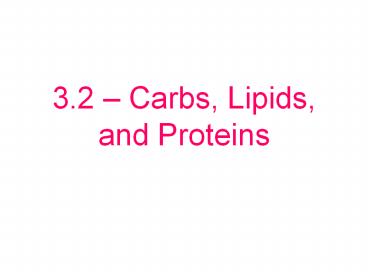3.2 - PowerPoint PPT Presentation
1 / 17
Title: 3.2
1
3.2 Carbs, Lipids, and Proteins
2
Element/Water Warm Up QUIZ Next Class
- Name the 4 most occurring elements in living
things - What is the function of sulfer?
- What is the function of sodium?
- Name and describe the 3 properties of water.
3
Carb, Lipid, Protein Pre-assessment
- C6H12O6 organic or inorganic
- CO2 organic or inorganic
- H2O organic or inorganic
- Organic compound made of amino acids
____________ - Organic compound made of monosaccharides
_______ - Fats and oils are which organic compound
_________ - Identify
4
Organic vs Inorganic Compounds
- Molecules are either organic or inorganic
- All organic molecules contain Carbon, but not
everything with C is organic - Ex Carbon dioxide is NOT organic
- We will discuss the following organic molecules
- Carb and monosaccharides
- Lipids and fatty acids/glycerol
- Proteins and amino acids
- Nucleic Acids and nucleotides
5
Proteins are made of Amino Acids
- Structure to Know
http//www.thevisualmd.com/health_centers/wellness
/nutrition_protein/what_are_proteins_video protein
http//www.thevisualmd.com/health_centers/wellness
/nutrition_protein/amino_acids AAs
6
(No Transcript)
7
Carbohydrate Class Activity
http//www.youtube.com/watch?v6esFOqj_IaY
- Each team/group will be assigned one oranic
molecule to research. On your paper you need to
state the name, type of organic molecule
(mono/di/poly), the function of it, and its role
in plants or animals. You may use the textbook
or computers. Ten minutes and then post on the
wall. Everyone will present their findings to
the class and you will record the information in
your notes so make your poster NEAT and COLORFUL. - Glucose 2. lactose 3. glyocogen 4.
fructose - 5. Galactose 6. maltose 7. sucrose 8.
starch - 9. Cellulose 10. ribose
8
To Review
Type of Carbohydrate Example Molecules
Monosaccharides Glucose, galactose, fructose, ribose
Disaccharides Maltose, lactose, sucrose
Polysaccharides Starch, glycogen, cellulose
9
To Review
Molecule Role in Plants or Animals
Glucose Chemical fuel for cell respiration in both plants and animals
Lactose Milk sugar to provide nutrients to mammal young
Glycogen To be the stored form of glucose in your liver and muscle cells (short term energy)
Fructose Provide nutrients to plants
Sucrose Used to transport and store energy in plants
Cellulose Primary component of plant cell walls
10
Structures to Know
- Glucose Ribose
- Fatty acids
11
Hydrolysis Reactions
- Humans eat food, but our digestive system (with
enzymes) breaks food down into its smallest
molecules so that our bodies can transport them
to where they are needed - Enzymes that break down polymers into monomers
are hydrolyzing enzymes - Ex lactose water ? glucose galactose
- Ex starch water(many) ? glucose(many)
- Ex triglyceride 3 water ? glycerol 3 fatty
acids - Ex protein water(many) ? amino acids(many)
12
Hydrolysis Reactions
13
Condensation/Dehydration Reactions
- Condensation reactions
- occur to re-form the larger molecules
- water is a product rather than a reactant
- require a different enzyme, one that is capable
of building covalent bonds rather than breaking
them - Ex glucose galactose ? lactose water
- Ex glucose (many) ? starch water (many)
- Ex glycerol 3 fatty acids ? triglyceride 3
water - Ex amino acids (many) ? protein water (many)
14
Lipids
- Solid lipids are fats, liquids are oils
- Role of Lipids
- 1. If you eat more than you burn, your body
stores fat for long-term in adipose cells these
cells swell or shrink depending on amount of fat
stored
Compared to carbs, an equal mass of a lipid can
store twice as much energycarbs used for
short-term energy storage
15
Lipids
- Role of Lipids
- 2. To provide thermal insulation
- ex fat (blubber) of cold-climate animals used
to keep them warm 30 of a seals body mass is
blubber
16
Lipids
- Role of Lipids
- 3. Phospholipids make up the cell membrane
17
Carbohydrates and Lipids
- Carbohydrates for short term energy storage
- Lipids store fat for long term energy can
contain twice as much energy as a carbohydrate
molecule































